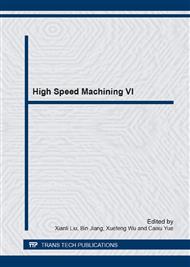p.644
p.649
p.654
p.660
p.666
p.672
p.678
p.684
p.688
Machining Error and Milling Process Control Methods for Joint Surface of Machine Tool
Abstract:
The existing processes of controlling machining error just controlled the maximum error. However, it did not effectively control the distribution of the error.The reliability of the assembly precision of the key joint surface did not meet the requirements, thereby affecting the service performance of machine tool. To solve this problem, the error matrix and transformation matrix was used to ascertain the location of joint surface positioning error occurred. The influence of processing error on the the positioning accuracy of machine tool was analyzed. The control objective of milling process was proposed. At the same time, the effects of cutting parameters on the processing error were also studied according to the milling experiments. The process error and its distribution characteristics of joint surface were obtained by analyzing the relationship between deformation of joint surface and cutting parameters. The milling process control methods were proposed.
Info:
Periodical:
Pages:
666-671
Citation:
Online since:
July 2014
Authors:
Keywords:
Price:
Сopyright:
© 2014 Trans Tech Publications Ltd. All Rights Reserved
Share:
Citation:


